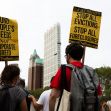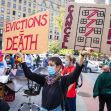Depending on who is asked, between 10 and 18 million people lost their jobs as a result of the coronavirus pandemic. Without paychecks, an estimated 11 million of them were not able to pay their rent. Last September, in an effort to avoid massive homelessness, the Centers for Disease Control and Prevention (CDC) and 17 states imposed eviction moratoriums. But most of these critical safeguards will end on or near June 30, putting more than four million people at risk of eviction or foreclosure according to the U.S. Census Bureau.
New York is the only state that has thus far extended its eviction moratorium to August 31. New York’s state legislature allocated $2.4 billion in funds from the federal government’s most recent stimulus package and added some additional funds of its own in April. The state adopted an emergency rent assistance program to help approximately one million renters or mortgage-holders across the state from being evicted. Program funds can cover rent for up to a year after March 13, 2020, and may be extended for an additional three months. Utilities can also be covered.
Of course, there are limits on eligibility. Applicant households must have incomes at or below 80% of the median incomes in their areas (AMI), or under $95,450 for a family of four, according to the website of the New York State Emergency Rental Assistance Program (ERAP). In addition, a member of the household must have received unemployment benefits or lost income as a result of the pandemic. Finally, a household member must be behind on rent starting in March 2020. The website also informs visitors that undocumented New Yorkers and those without legal immigration status can qualify for rent relief.
In recognition of the fact that the application process can be daunting for many state residents, a portion of the funding has been reserved for a dozen community groups that can provide application assistant and translation. Upon approval, payments will be sent directly to landlords to cover unpaid rent. Because application forms require information and signatures from both landlords and tenants, ERAP cautions “the application process will go most smoothly if tenants and landlords are able to cooperate.”
New York’s payments will also be prioritized to reach those most in need first. Those at or below 50% of AMI’s or at $59,650 for a family of four, or those who are currently out of work, have pending eviction cases, or living in communities “disproportionality impacted” by COVID-19 according to zip codes, will be reviewed first.
There are limitations on landlords as well. They may not charge late fees on rent that is owed, and in most cases, they may neither raise rent nor evicts tenants for a year due to expired leases.
Cooperation between landlords and tenants has not always been easy and has led to numerous lawsuits that contributed to the demise of the CDC’s protection. On May 5 of this year, a federal judge in Texas struck down the national eviction moratorium. On May 10, a federal district court judge for the District of Columbia ruled that the CDC’s action went beyond the agency’s statutory authority and vacated it nationwide.
White House spokesperson Jen Psaki cited a recent study that estimated there were 1.5 million fewer evictions last year than had been expected. But landlords have fought the policy, arguing they cannot afford to continue housing people for free. They estimate lost rental payments of up to $70 billion. On the other hand, most payments go directly to landlords, eliminating the possibility that recipients could use the funds for anything other than rent or mortgage payments.
On the whole, most observers believe that the moratorium policy has been what critics have called “less than perfect.” CNBC reported that “while the moratorium slowed the displacement of families, it has failed to keep many other people in their homes,” and “tens of thousands of evictions have occurred” since the moratorium went into effect.” It was, however, an “unprecedented” effort. During the Great Recession, renters were given only $1.5 billion according to the National Low Income Housing Coalition.
Another problem has been the difficulties states have faced in disbursing federal funds. Estimates put the amount of undistributed funds at up to $45 billion.
Even so, the end of the CDC mandate in states other than New York can soon cause evictions to “skyrocket.” The Center on Budget and Policy Priorities estimates that around 15% of all adult renters are behind in housing payments. John Pollock, coordinator of the National Coalition for a Civil Right to Counsel told CNBC, “We’re going to see what we’ve been managing to stave off: this wave of evictions that is just going to crush some of these areas.”
The good news is that some Americans, regardless of the state in which they reside, may still be protected under the CDC moratorium if they and their landlord successfully complete the agency’s Eviction Protection Declaration. It is limited to those who either received stimulus checks in 2020 or 2021, those who were not required to report income to the IRS in 2020, or those who earned less than $99,000 for single people or $198,000 for joint filers in 2020 or 2021. Importantly, they must also have “extraordinary medical expenses,” been laid off, seen significant drops in income, or have had their wages or work hours decreased.
Eviction rates will vary from state to state, depending on factors such as the state’s economy, current housing prices, unemployment by industry, and demographics. For example, researchers have found that Black renters are about four times as likely to owe rent than white renters, and older Americans also face higher risks.
In addition to specific rental or mortgage assistance, a few other programs may assist those in danger of displacement. The American Rescue Plan can provide $300 per week in extra unemployment benefits until September 6, 2021; the CARES Act may give unemployment benefits to independent contractors, and there may be state unemployment benefits.
Despite these alternatives, it is likely to be a confusing and rocky road ahead for those who can’t pay their rent. Unless they live in New York for the time being.






